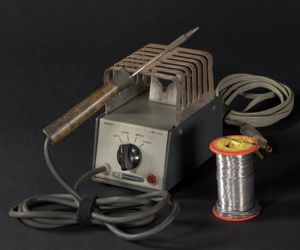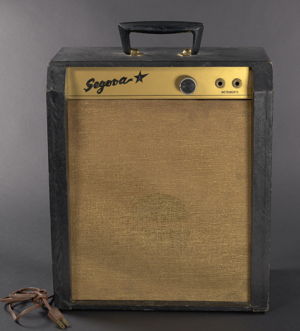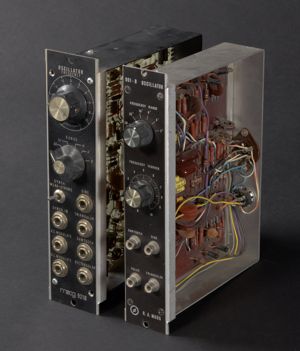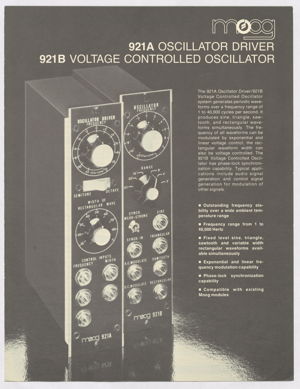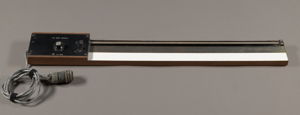Moog Company Products and Inventions
Heathkit GH-17A. Soldering iron and wire, ca. 1970s. (1 image)
With ready access to his dad’s workshop as a kid, Bob was an inveterate tinkerer. Along with an oscilloscope, a soldering iron was his main tool. He also had good musical ears, having taken piano lessons for many years at his mother’s insistence. He would mess around with circuits until he got the sound he wanted. His familiarity with music meant he could partner closely with musicians such as Herb Deutsch, Wendy Carlos, and Keith Emerson to improve his designs. Most of his early customers were located in New York City, so he would often take a Greyhound bus to the city along with the cargo of a synthesizer in cardboard cartons. Upon arrival in the city, he would take a cab and install the synthesizer in their studios himself. He did this for the second customer he ever had, Eric Siday, who used his custom-built Moog to make TV ads (including the famous Maxwell House ad).
With ready access to his dad’s workshop as a kid, Bob was an inveterate tinkerer. Along with an oscilloscope, a soldering iron was his main tool. He also had good musical ears, having taken piano lessons for many years at his mother’s insistence. He would mess around with circuits until he got the sound he wanted. His familiarity with music meant he could partner closely with musicians such as Herb Deutsch, Wendy Carlos, and Keith Emerson to improve his designs. Most of his early customers were located in New York City, so he would often take a Greyhound bus to the city along with the cargo of a synthesizer in cardboard cartons. Upon arrival in the city, he would take a cab and install the synthesizer in their studios himself. He did this for the second customer he ever had, Eric Siday, who used his custom-built Moog to make TV ads (including the famous Maxwell House ad).
R.A. Moog Co. Amplifier, ca 1965. (1 image)
Before making synthesizers, Bob made cheap guitar amplifiers as a means of generating income for his more ambitious R&D operations. The components were made in Trumansburg and shipped to New York City, where Moog’s collaborator, Walter Sear, would assemble them. R.A. Moog Co. made thousands of these amps, thereby providing a significant amount of the company's income in the 1960s. The brand name “Segova” conjures up the famous Spanish guitarist Andre Segovia. The name was later changed to “Sekova” to prevent a law suit.
Before making synthesizers, Bob made cheap guitar amplifiers as a means of generating income for his more ambitious R&D operations. The components were made in Trumansburg and shipped to New York City, where Moog’s collaborator, Walter Sear, would assemble them. R.A. Moog Co. made thousands of these amps, thereby providing a significant amount of the company's income in the 1960s. The brand name “Segova” conjures up the famous Spanish guitarist Andre Segovia. The name was later changed to “Sekova” to prevent a law suit.
On loan from the collection of Brian Kehew.
R.A. Moog Co. Oscillator. 901-B Prototype from Moog’s Second Modular Synthesizer, owned by Eric Siday, ca. 1964. Shown with Oscillator. Model 921B, 1974. (2 images)
The guts of any analog synthesizer are its oscillators. The Moog oscillators displayed here produced a variety of simple wave forms with different musical sounds and properties. The frequency of these oscillators could be controlled by inputting voltages from patch cords connected to the outputs of other modules. Each module was connected by “patch cords” with ¼-inch jack plugs. The amount of voltage could be altered by a variable resistance known as a potentiometer. Nearly all the knobs you see on analog synthesizers are potentiometers or “pots.” This technology is known as voltage control. A simple sine wave fed in as an input could modulate the pitch to produce the musical effect of vibrato, for instance. More intricate patches created more complex and interesting sounds.
The guts of any analog synthesizer are its oscillators. The Moog oscillators displayed here produced a variety of simple wave forms with different musical sounds and properties. The frequency of these oscillators could be controlled by inputting voltages from patch cords connected to the outputs of other modules. Each module was connected by “patch cords” with ¼-inch jack plugs. The amount of voltage could be altered by a variable resistance known as a potentiometer. Nearly all the knobs you see on analog synthesizers are potentiometers or “pots.” This technology is known as voltage control. A simple sine wave fed in as an input could modulate the pitch to produce the musical effect of vibrato, for instance. More intricate patches created more complex and interesting sounds.
On loan from the collection of Roger Luther.
Moog Synthesizers. Specifications and Sales Brochure. Model 921A (Oscillator Driver) and Model 921B (Voltage Controlled Oscillator). Norlin, 1976. (3 images)
R.A. Moog Co. Ribbon Controller, ca. 1970. (1 image)
Invented in 1968, this particular ribbon controller from Bob’s archive was the 151st one built at the Trumansburg factory. All analog synths are operated by what are known as controllers. In the modular Moog, the most obvious controllers were the potentiometers (or “pots”) that controlled voltages going in and out of modules via patch cords. Bob added a keyboard from an organ, which enabled the chromatic scale to be played one note at a time (monophonically). But Bob’s experience building Theremins meant he was accustomed to controllers that responded to sweeping gestures rather than the discrete manipulation of individual keys, so he devised what became known as the “ribbon controller.” Like a potentiometer, this relied on variable resistance, but was arranged longitudinally so the voltage could be changed by pushing a finger against the resistance strip and, if need be, by sliding the finger along the ribbon to make the pitch glide smoothly up and down. The ribbon controller, which was also available on the Minimoog and the Polymoog, was popular among the more experimental and avant-garde users of the Moog. The Beach Boys used an early form of this controller when performing their hit song “Good Vibrations” (1966). Keith Emerson’s ribbon controller eventually malfunctioned, producing staccato stabs rather than legato sweeps. Keith, ever the showman, loved this effect and ran into the audience with his ribbon controller making machine gun noises. On one famous occasion he overestimated the cable’s length and ended up in the audience on his backside!
Invented in 1968, this particular ribbon controller from Bob’s archive was the 151st one built at the Trumansburg factory. All analog synths are operated by what are known as controllers. In the modular Moog, the most obvious controllers were the potentiometers (or “pots”) that controlled voltages going in and out of modules via patch cords. Bob added a keyboard from an organ, which enabled the chromatic scale to be played one note at a time (monophonically). But Bob’s experience building Theremins meant he was accustomed to controllers that responded to sweeping gestures rather than the discrete manipulation of individual keys, so he devised what became known as the “ribbon controller.” Like a potentiometer, this relied on variable resistance, but was arranged longitudinally so the voltage could be changed by pushing a finger against the resistance strip and, if need be, by sliding the finger along the ribbon to make the pitch glide smoothly up and down. The ribbon controller, which was also available on the Minimoog and the Polymoog, was popular among the more experimental and avant-garde users of the Moog. The Beach Boys used an early form of this controller when performing their hit song “Good Vibrations” (1966). Keith Emerson’s ribbon controller eventually malfunctioned, producing staccato stabs rather than legato sweeps. Keith, ever the showman, loved this effect and ran into the audience with his ribbon controller making machine gun noises. On one famous occasion he overestimated the cable’s length and ended up in the audience on his backside!
